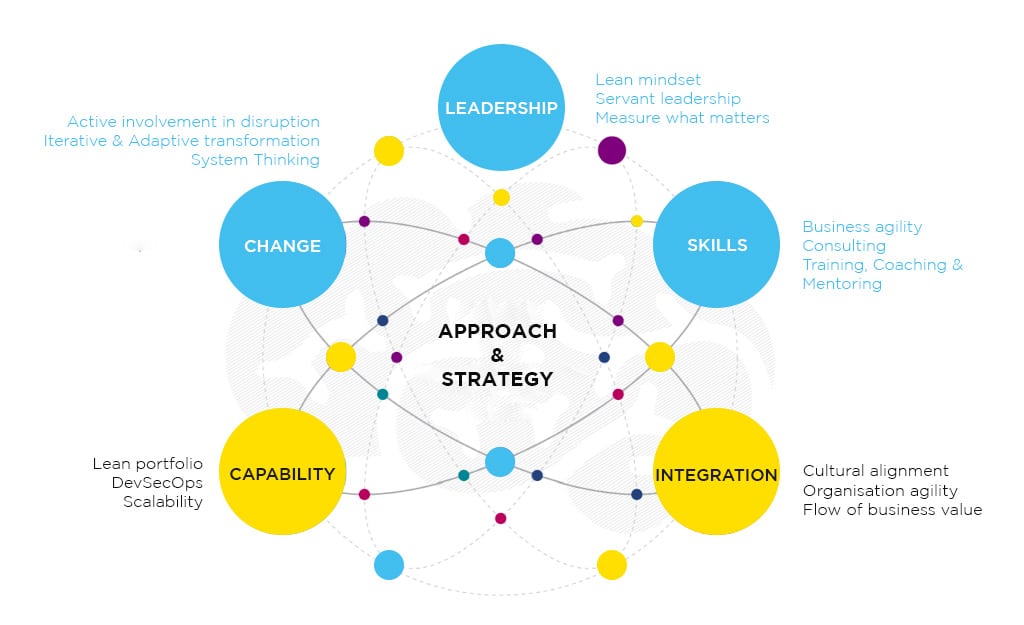What is Agile Project Management?
Agile methodology responds to the output of project teams and client needs in short development cycles and more frequent product releases, called iterations. This differs from traditional project management, such as the “waterfall approach,” which aims for a single implementation at project completion. In the Agile process, customer collaboration takes priority over contract negotiation and aims to streamline the amount of work required.
Agile methodology
There are several Agile frameworks and Agile methods, including Scrum and Kanban, that have emerged since the 2001 meeting that hammered out the Agile Manifesto. Each follows the 6-part Agile methodology that has been adopted by many project management approaches.
- Project planning to determine the goal and its value to the stakeholder. Then, how to achieve it, allowing for changes along the way
- Set out a roadmap of features to be included in the final product. Include a product backlog listing all features and deliverables
- Embrace the sprint, the short development cycle that produces new project features
- Sprint planning meetings, when stakeholders determine what will be accomplished by each person during that sprint and how it will be achieved
- Daily stand-ups, when the sprint team meet briefly to assess progress and make necessary changes
- The sprint review and sprint retrospective are held at the end of each sprint. At the sprint review, project stakeholders see a functional iteration of the working finished product.
At the sprint retrospective meeting, stakeholders discuss with the team what was best accomplished in this iteration, what could have been improved, and assess the amount of work for each team member. Embedded in Agile principles, this is an essential meeting for every stakeholder and product owner.
Agile project management

Because Agile methodology is simple to use, its techniques are adaptable to most industries. Originally created for Agile software development and by software engineers, the Agile approach to project planning and management is adaptable to any business, because every business has a system in place to track progress and accomplish tasks. Proofed by iterations of working software, application or software development and functionality remain the backbone of most Agile projects.
What are the 5 phases of Agile project management?
- Concept – defining the project scope, documenting the key requirements and estimating timelines and budget.
- Inception – putting together the development team and equipping them with the necessary tools to design and build the product.
- Iteration – the construction or build phase where the team work through development cycles to achieve their goals.
- Release – the final phase of testing and quality assurance to ensure the final product is ready to launch, using testers, the project team and automation.
- Maintenance – once deployed, the product requires ongoing support to fix or upgrade it over time.
Some cite a sixth phase in the product lifecycle – retirement. That’s when the app, software or product is being replaced or has become obsolete and is no longer required by the organisation.
How does Agile project management work in a team?
Each Agile team is unique and uses the Agile project management methodology that works best for them. These self organizing teams have the autonomy to produce the best results possible in a fast-paced environment. The Agile process begins by accepting that there will be uncertainty and a lack of predictability, so the entire development team is ready to respond to change, focused always upon functionality and continuous improvement. Commonly used in software development projects because of its speed and adaptability, this iterative approach makes quick evaluation and change possible. It replaces the need to produce constant comprehensive documentation.
Once planning meetings are concluded and a product development project is ready to begin, the scope and stages of the project should be clear to the Agile project team and all stakeholders. A roadmap will break down the features to be implemented in the high-quality deliverables that will shape the project lifecycle, and secure real-time stakeholder engagement and satisfaction. This sustainable development model makes it possible for business stakeholders, the development team, and customers to maintain a constant and unconstrained pace throughout the development process.
To ensure stakeholder and end-user satisfaction, the Agile project planning and project management workflow embraces
- User stories, usually a short outline written from a client’s perspective to estimate how much work needs to be done and what the final product should look like
- Sprints: short development cycles, usually lasting one to three weeks. With customer collaboration, teams plan the work to be carried out within each sprint and present and review at the end of each sprint, each complete iteration
- The Agile board, which can be a white board or a project management software function is used to keep track of the team’s work in progress
- The product backlog, a list of deliverables still outstanding in the project. In the sprint planning process items from this list are moved into the sprint, as needed.
Other Agile project management tools include Kanban boards, Lean and Extreme Programming (XP).
The scrum and the scrum master
The Development Team has a short daily standup — called a Daily Scrum — to report and evaluate the previous day’s work and progress, the new day’s focus, and all identified risks. Clear core scrum values are self-organization, dedication, respect, and, most importantly, empirical research to find the best approach for product development and customer satisfaction.
The Scrum Master is the person in charge who supports the progress of the project among team members according to the product owner’s instructions. The Scrum Master’s responsibilities are clear: to facilitate sprint activities, daily meetings, and the sprint review; to communicate with team members about changing needs and coach team members to achieve outcomes; to manage meetings, collaboration, and impediments to project progress; to implement the scrum framework; and to coordinate with the product owner. They may also implement changes, coordinate with stakeholders to obtain necessary resources, and help product owners to optimize backlog planning for best performance, always fostering transparency and collaboration among the Scrum Team.
What is the difference between Waterfall and Agile Project Management Methodologies?
Agile methodology: one of the fundamentals of agile project management methodology is ongoing amends and iterations led by team, user or customer feedback. It often refers to the ability to build and act on changes in increments as the project and its outcomes develop. This technique of making continuous improvements is useful in, what can be, an unpredictable environment where change needs quick adaptation.
Waterfall project management is the more traditional method of software development. The organizing principles are linear and sequential, geared to produce a single successful project delivery. It is also referred to as Linear Sequential Life Cycle Model.
View our comparison of Agile Methodology vs. Waterfall Methodology
How Do Both Differ From Scrum Agile Project Management?
Scrum is a type of agile methodology that is used to guide teams overall. It is often used for the agile project management framework overall, but like agile, allows various teams to respond efficiently, and effectively to change.
How Does Agile Project Management Work?
The key part about agile project management, is that not only does it add flexibility to the team, but it lets the customers have early and frequent opportunities to assess the project and/or work being delivered. They are free to make decisions and ask for changes throughout the project and can change the original set up as they go.
How to Use Agile Project Management in Your Business
Whether Agile or Waterfall, there are pros and cons to each of the software development methodologies. We can help train your team to identify which is the suitable answer for your situation overall.
Learn more about Agile Methodology and training with online courses from Leadership Tribe today, including recognised PMI certifications.


